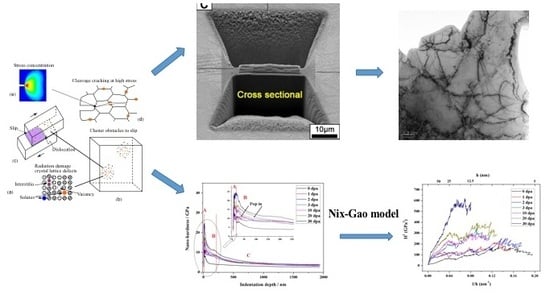Effect of Heavy Ion Irradiation Dosage on the Hardness of SA508-IV Reactor Pressure Vessel Steel
Abstract
:1. Introduction
2. Experimental Procedures
2.1. Testing Materials and Irradiation Conditions
2.2. Microstructure Observation
2.3. Nano-Indentation Tests
3. Results and Discussion
3.1. Microstructure
3.2. Nano-Hardness
4. Conclusions
- (1)
- The CSM nano-hardness profiles of the irradiated SA508-IV steel samples exhibit a maximum value and a plateau.
- (2)
- The maximum nano-hardness (Hmax) increases rapidly at low doses and slowly at higher doses. The relationship between Hmax and dpa follows a ½-power law.
- (3)
- The inflection point of the bilinear curve is the point separating the B region and C region on the CSM nano-hardness profile. Beyond the inflection point, the ion irradiation effect on the materials is insignificant.
- (4)
- The characteristic length l* which is affected by ion-irradiation was obtained by fitting the bilinear curves, and also had a relationship with the displacement per atom (dpa).
Acknowledgments
Author Contributions
Conflicts of Interest
References
- Chen, Y.T.; Atteridge, D.G.; Gerberich, W.W. Plastic flow of Fe-binary alloys-I. A description at low temperatures. Acta Metall. 1981, 29, 1171–1185. [Google Scholar] [CrossRef]
- Gerberich, W.W.; Chen, Y.T.; Atteridge, D.G.; Johnson, T. Plastic flow of Fe-binary alloys-II. Application of the description to the ductile-brittle transition. Acta Metall. 1981, 29, 1187–1201. [Google Scholar] [CrossRef]
- Zhang, H.; Zhang, C.; Yang, Y.; Meng, Y.; Jang, J.; Kimura, A. Irradiation hardening of ODS ferritic steels under helium implantation and heavy-ion irradiation. J. Nucl. Mater. 2014, 455, 349–353. [Google Scholar] [CrossRef]
- Liu, P.P.; Bai, J.W.; Ke, D.; Wan, F.R.; Wang, Y.B.; Wang, Y.M.; Ohnuki, S.; Zhan, Q. Effects of deuterium implantation and subsequent electron irradiation on the microstructure of Fe-10Cr model alloy. J. Nucl. Mater. 2012, 423, 47–52. [Google Scholar] [CrossRef]
- Klueh, R.L.; Gelles, D.S.; Jitsukawa, S.; Kimura, A.; Odette, G.R.; van der Schaaf, B.; Victoria, M. Ferritic/martensitic steels-overview of recent results. J. Nucl. Mater. 2002, 307, 455–465. [Google Scholar] [CrossRef]
- Zhang, C.H.; Sun, Y.M.; Song, Y.; Shibayama, T.; Jin, Y.F.; Zhou, L.H. Defect production in silicon carbide irradiated with Ne and Xe ions with energy of 2.3 MeV/amu. Nucl. Instrum. Methods Phys. Res. B 2007, 256, 243–247. [Google Scholar] [CrossRef]
- Fujii, K.; Fukuya, K.; Hojo, T. Effects of dose rate change under irradiation on hardening and microstructural evolution in A533B steel. J. Nucl. Sci. Technol. 2013, 50, 160–168. [Google Scholar] [CrossRef]
- Zhang, Z.W.; Liu, C.T.; Wang, X.L.; Miller, M.K.; Ma, D.; Chen, G.; Williams, J.R.; Chin, B.A. Effects of proton irradiation on nanocluster precipitation in ferritic steel containing fcc alloying additions. Acta Mater. 2012, 60, 3034–3046. [Google Scholar] [CrossRef]
- Was, G.S.; Busby, J.T.; Allen, T.; Kenik, E.A.; Jenssen, A.; Bruemmer, S.M.; Gan, J.; Edwards, A.D.; Scott, P.M.; Andresen, P.L. Emulation of neutron irradiation effects with protons: Validation of principle. J. Nucl. Mater. 2002, 300, 198–216. [Google Scholar] [CrossRef]
- Liu, P.P.; Wan, F.R.; Zhan, Q. A model to evaluate the nano-indentation hardness of ion-irradiated materials. Nucl. Instrum. Methods Phys. Res. B 2015, 342, 13–18. [Google Scholar] [CrossRef]
- Fischer-Cripps, A.C. Nanoindentation Testing, Nanoindentation; Springer: Berlin, Germany, 2011. [Google Scholar]
- Li, X.D.; Bhushan, B. A review of nanoindentation continuous stiffness measurement technique and its applications. Mater. Charact. 2002, 48, 11–36. [Google Scholar] [CrossRef]
- Fujii, K.; Fukuya, K.; Hojo, T. Concomitant formation of different nature clusters and hardening in reactor pressure vessel steels irradiated by heavy ions. J. Nucl. Mater. 2013, 443, 378–385. [Google Scholar] [CrossRef]
- Hengstler-Eger, R.M.; Baldo, P.; Beck, L.; Dorner, J.; Ertl, K.; Hoffmann, P.B.; Hugenschmidt, C.; Kirk, M.A.; Petry, W.; Pikart, P.; et al. Heavy ion irradiation induced dislocation loops in AREVA’s M5 alloy. J. Nucl. Mater. 2012, 423, 170–182. [Google Scholar] [CrossRef]
- Bai, X.; Wu, S.; Liaw, P.K. Influence of thermo-mechanical embrittlement processing on microstructure and mechanical behavior of a pressure vessel steel. Mater. Des. 2016, 89, 759–769. [Google Scholar] [CrossRef]
- Klueh, R.L.; Hashimoto, N.; Sokolov, M.A.; Shiba, K.; Jitsukawa, S. Mechanical properties of neutron-irradiated nickel-containing martensitic steels: I. Experimental study. J. Nucl. Mater. 2006, 357, 156–168. [Google Scholar] [CrossRef]
- Klueh, R.L.; Hashimoto, N.; Sokalov, M.A.; Maziasz, P.J.; Shiba, K.; Jitsukawa, S. Mechianical properties of neutron-irradiated nickel-containing martensitic steels: II. Review and analysis of helium-effects studies. J. Nucl. Mater. 2006, 357, 169–182. [Google Scholar] [CrossRef]
- Bai, X.; Wu, S.; Liaw, P.K.; Shao, L.; Gigax, J.; Wei, L. Effect of ion irradiation on microstructure and nano-hardness of the SA508-IV reactor pressure vessel steel. Sci. Rep. submitted for publication. 2017. [Google Scholar]
- Pharr, G.M.; Herbert, E.G.; Gao, Y. The indentation size effect: A critical examination of experimental observations and mechanistic interpretations. Annu. Rev. Mater. Res. 2010, 40, 271–292. [Google Scholar] [CrossRef]
- Kasada, R.; Takayama, Y.; Yabuuci, K.; Kimura, A. A new approach to evaluate irradiation hardening of ion-irradiated ferritic alloys by nano-indentation techniques. Fusion Eng. Des. 2011, 86, 2658–2661. [Google Scholar] [CrossRef] [Green Version]
- Jiang, J.; Wu, Y.C.; Liu, X.B.; Wang, R.S.; Nagai, Y.; Inoue, K.; Shimizu, Y.; Toyama, T. Microstructural evolution of RPV steels under proton and ion irradiation studied by positron annihilation spectroscopy. J. Nucl. Mater. 2015, 458, 326–334. [Google Scholar] [CrossRef]
- Nix, W.D.; Gao, H. Indentation size effects in crystalline materials: A law for strain gradient plasticity. J. Mech. Phys. Solids 1998, 46, 411–425. [Google Scholar] [CrossRef]
- Yabuuchi, K.; Yano, H.; Kasada, R.; Kishimoto, H.; Kimura, A. Dose dependence of irradiation hardening of binary ferritic alloys irradiated with Fe3+ ions. J. Nucl. Mater. 2011, 417, 988–991. [Google Scholar] [CrossRef]
- Akamatsu, M.; van Duysen, J.C.; Pareige, P.; Auger, P. Experimental evidence of several contributions to the radiation damage in ferritic alloys. J. Nucl. Mater. 1995, 225, 192–195. [Google Scholar] [CrossRef]
- Tobita, T.; Suzuki, M.; Iwase, A.; Aizawa, K. Hardening of Fe-Cu alloys at elevated temperatures by electron and neutron irradiaions. J. Nucl. Mater. 2001, 299, 267–270. [Google Scholar] [CrossRef]
- Bohmert, J.; Viehrig, H.-W.; Ulbricht, A. Correlation between irradiation-induced changes of microstructural parameters and mechanical properties of RPV steels. J. Nucl. Mater. 2004, 334, 71–78. [Google Scholar] [CrossRef]
- Takayama, Y.; Kasada, R.; Sakamoto, Y.; Yabuuchi, K.; Kimura, A.; Ando, M.; Hamaguchi, D.; Tanigawa, H. Nanoindentation hardness and its extrapolation to bulk-equivalent hardness of F82H steels after single- and dual-ion beam irradiation. J. Nucl. Mater. 2013, 442, S23–S27. [Google Scholar] [CrossRef]
- Nishiyama, Y.; Onizawa, K.; Suzuki, M.; Anderegg, J.W.; Nagai, Y.; Toyama, T.; Hasegawa, M.; Kameda, J. Effects of neutron-irradiation-induced intergranular phosphorus segregation and hardening on embrittlement in reactor pressure vessel steels. Acta Mater. 2008, 56, 4510–4521. [Google Scholar] [CrossRef]
- Shibamoto, H.; Kitao, K.; Matsui, H.; Hasegawa, M.; Yamaguchi, S.; Kimura, A. Effects of Radiation on Materials, 20th International Symposium, ASTM STP 1405; Rosinski, S.T., Grossbeck, M.L., Allen, T.R., Kumar, A.S., Eds.; American Society for Testing and Materials: West Conshohocken, PA, USA, 2001; p. 722. [Google Scholar]
- Watanabe, H.; Arase, S.; Yamamoto, T.; Wells, P.; Onishi, T.; Odette, G.R. Hardening and microstructural evolution of A533b steels irradiated with Fe ions and electrons. J. Nucl. Mater. 2016, 471, 243–250. [Google Scholar] [CrossRef]
- Liu, P.P.; Zhao, M.Z.; Zhu, Y.M.; Bai, J.W.; Wan, F.R.; Zhan, Q. Effects of carbide precipitate on the mechanical properties and irradiation behavior of the low activation martensitic steel. J. Alloy. Compd. 2013, 579, 599–605. [Google Scholar] [CrossRef]
- Radiguet, B.; Pareige, P.; Barbu, A. Irradiation induced clustering in low copper or copper free ferritic model alloys. Nucl. Instrum. Methods Phys. Res. B 2009, 267, 1496–1499. [Google Scholar] [CrossRef]
- Qian, X.; Han, L.; Zhang, W.; Gu, J. Nano-indentation investigation on the mechanical stability of individual austenite in high-carbon steel. Mater. Charact. 2015, 110, 86–93. [Google Scholar]
- Kim, B.; Trang, T.T.T.; Kim, N.J. Deformation behavior of ferrite-austenite duplex high nitrogen steel. Met. Mater. Int. 2014, 20, 35–39. [Google Scholar] [CrossRef]
- Mistra, R.D.K.; Zhang, Z.; Jia, Z.; Venkat Surya, P.K.C.; Somani, M.C.; Karjalainen, L.P. Nanomechanical insights into the deformation behavior of austenitic alloys with different stacking fault energies and austenitic stability. Mater. Sci. Eng. A 2011, 528, 6958–6963. [Google Scholar] [CrossRef]
- Bahr, D.F.; Kramer, D.E.; Gerberich, W.W. Non-linear deformation mechanisms during nano-indentation. Acta Mater. 1998, 46, 3605–3617. [Google Scholar] [CrossRef]

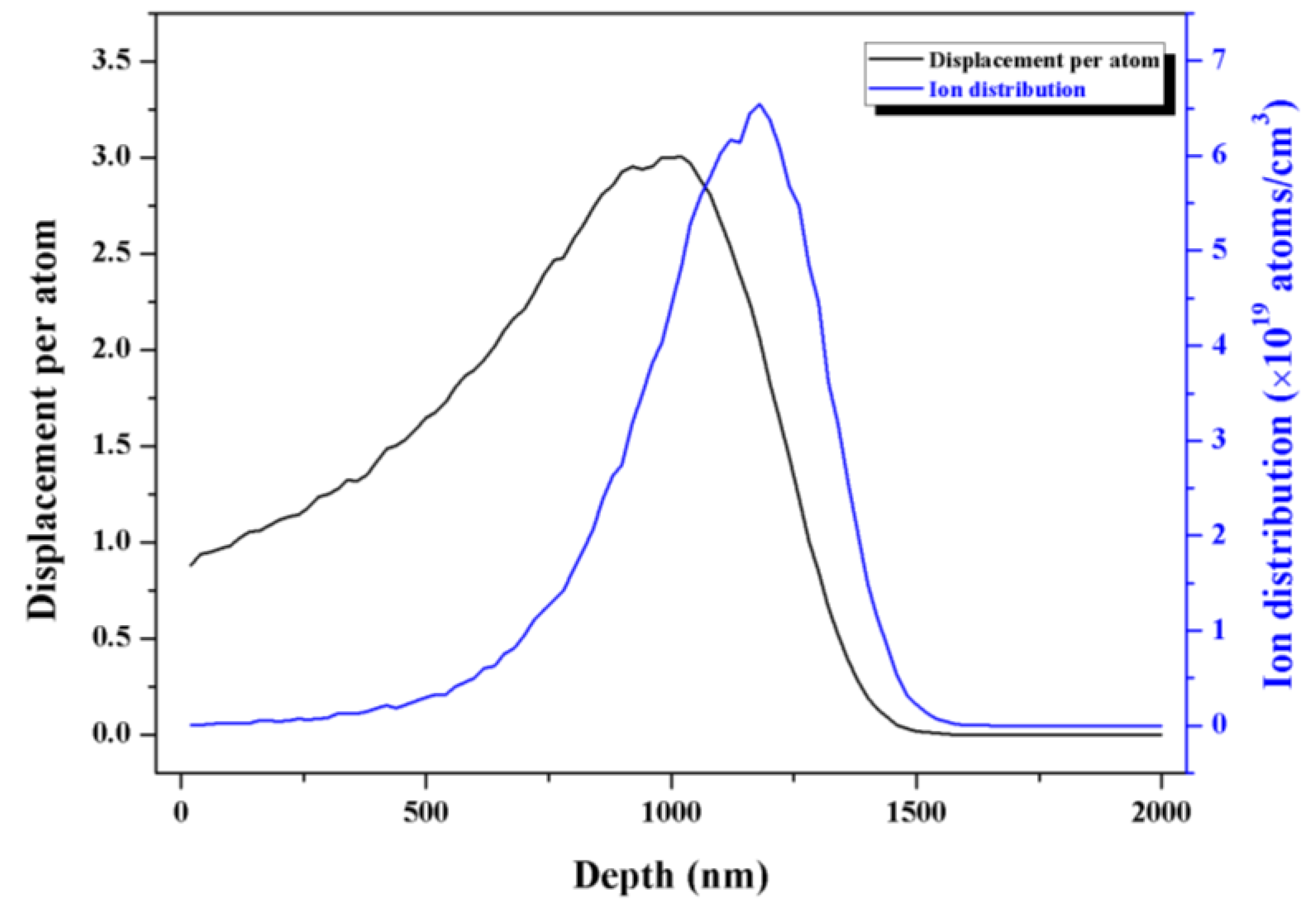
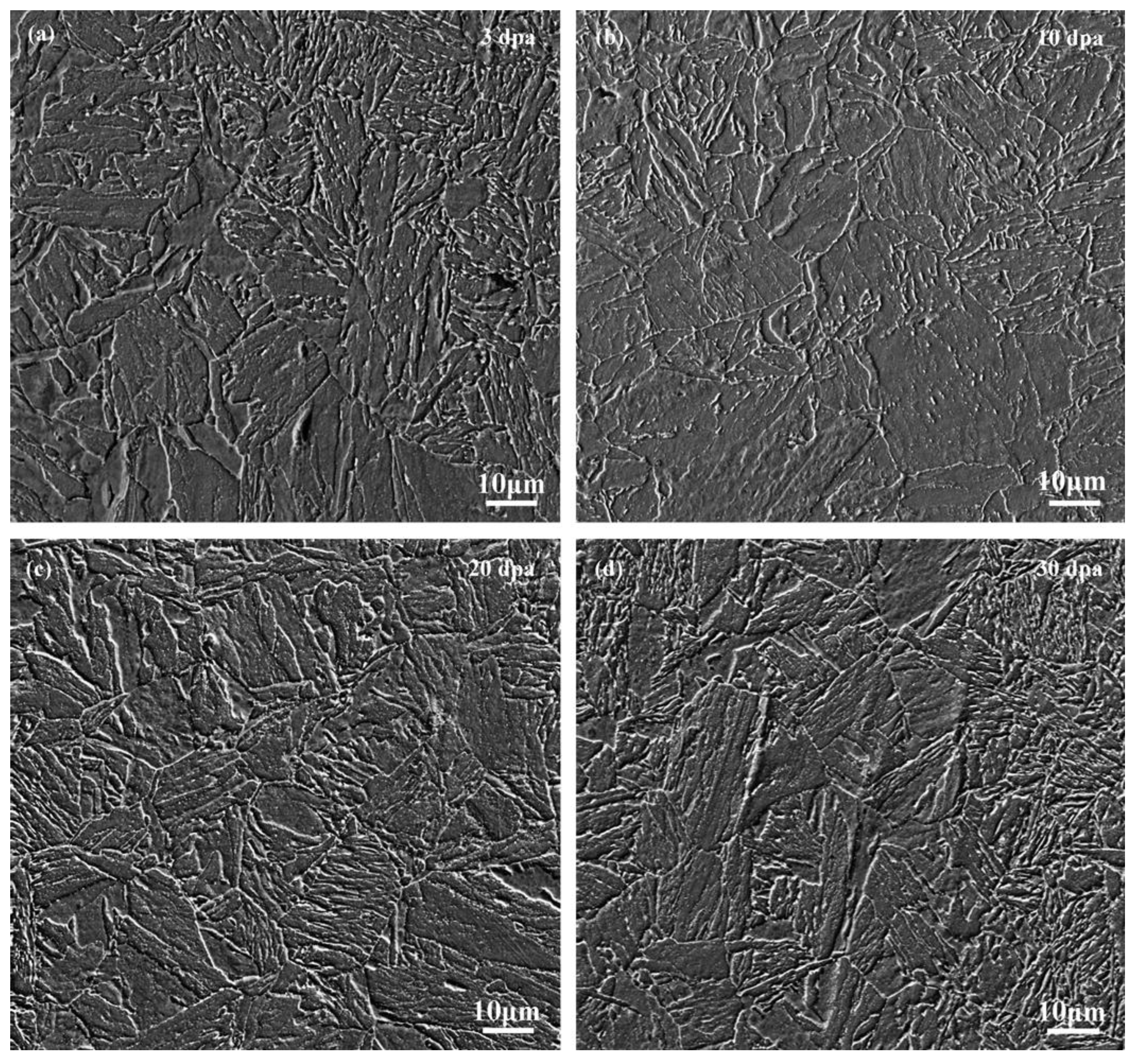

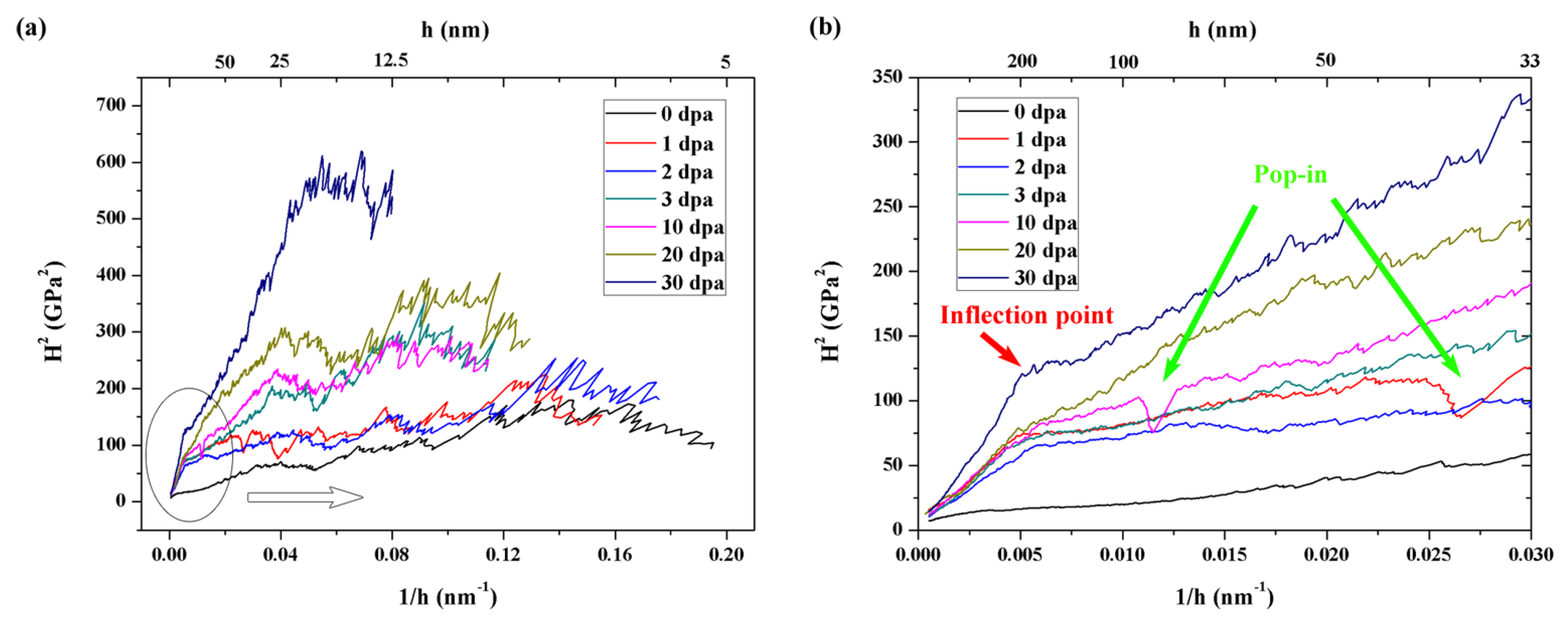
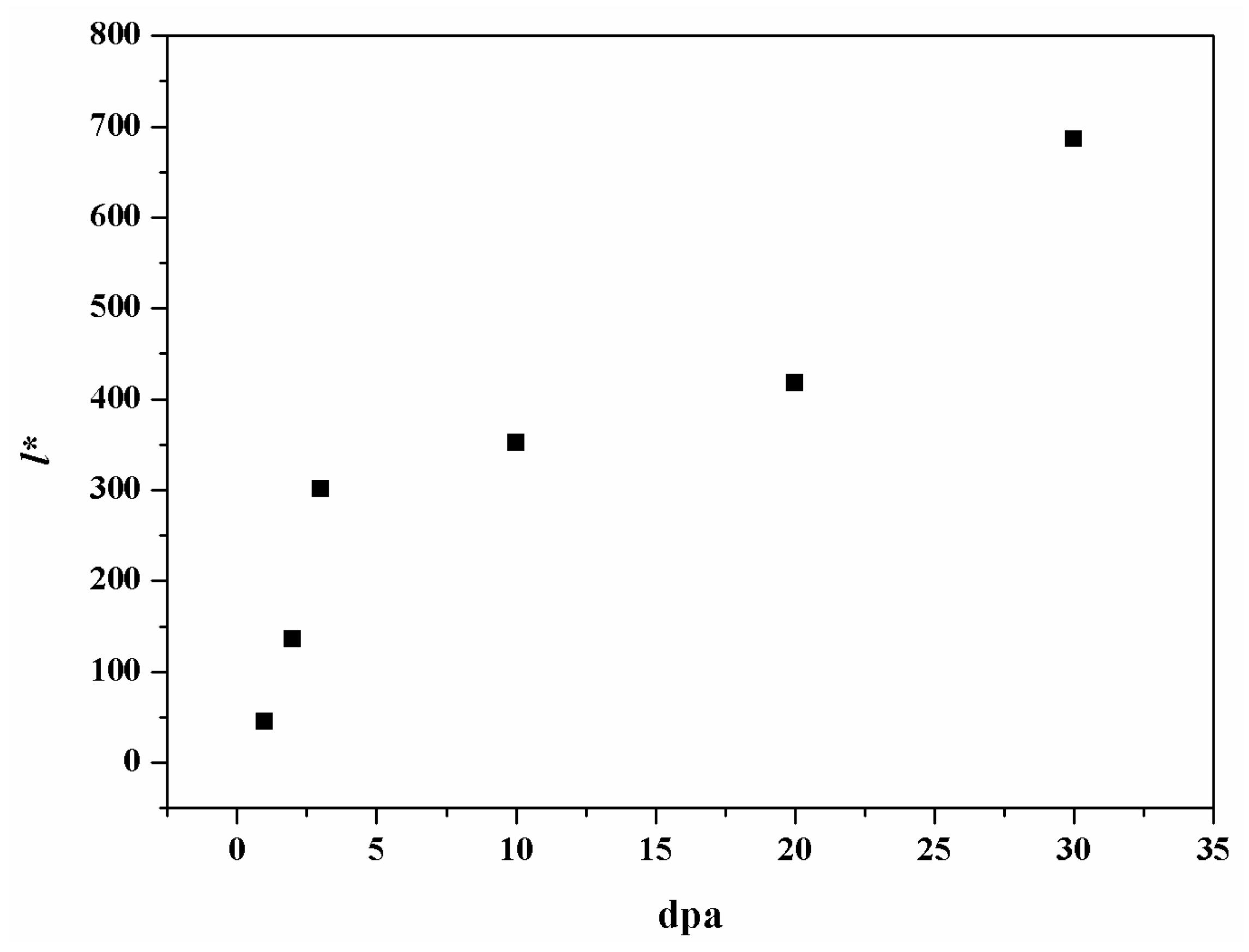
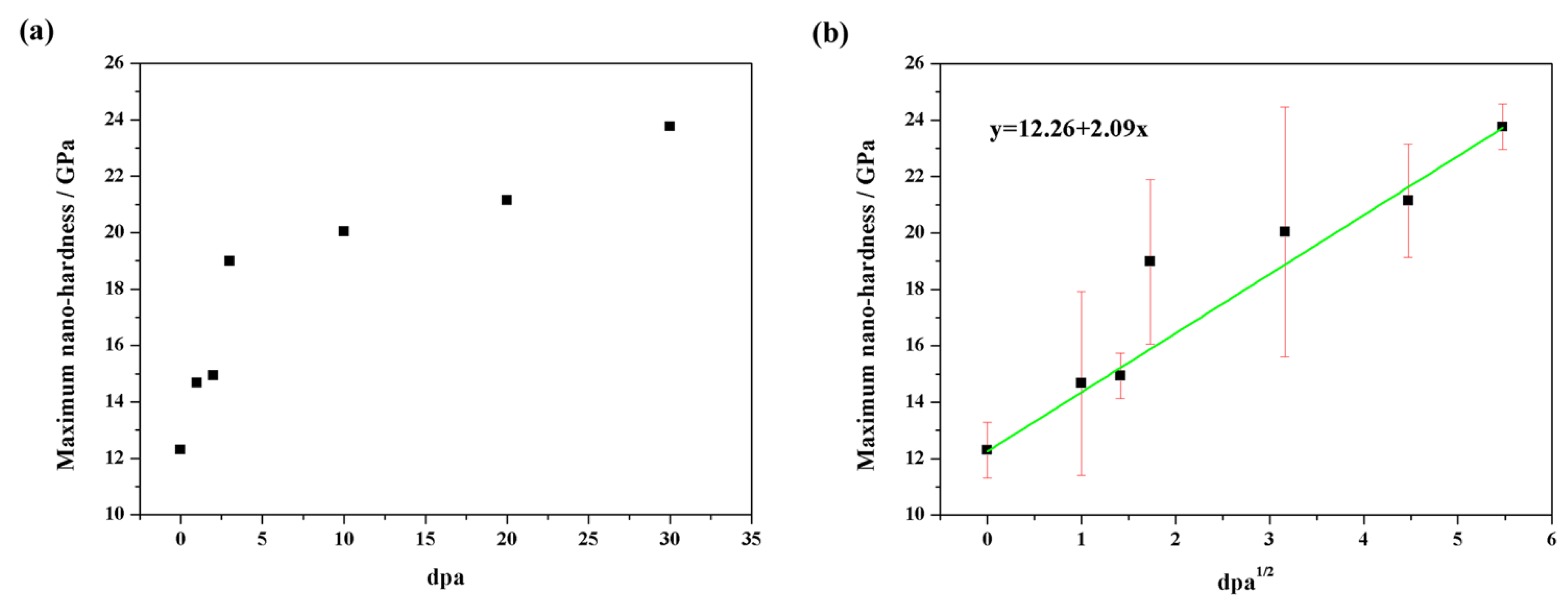
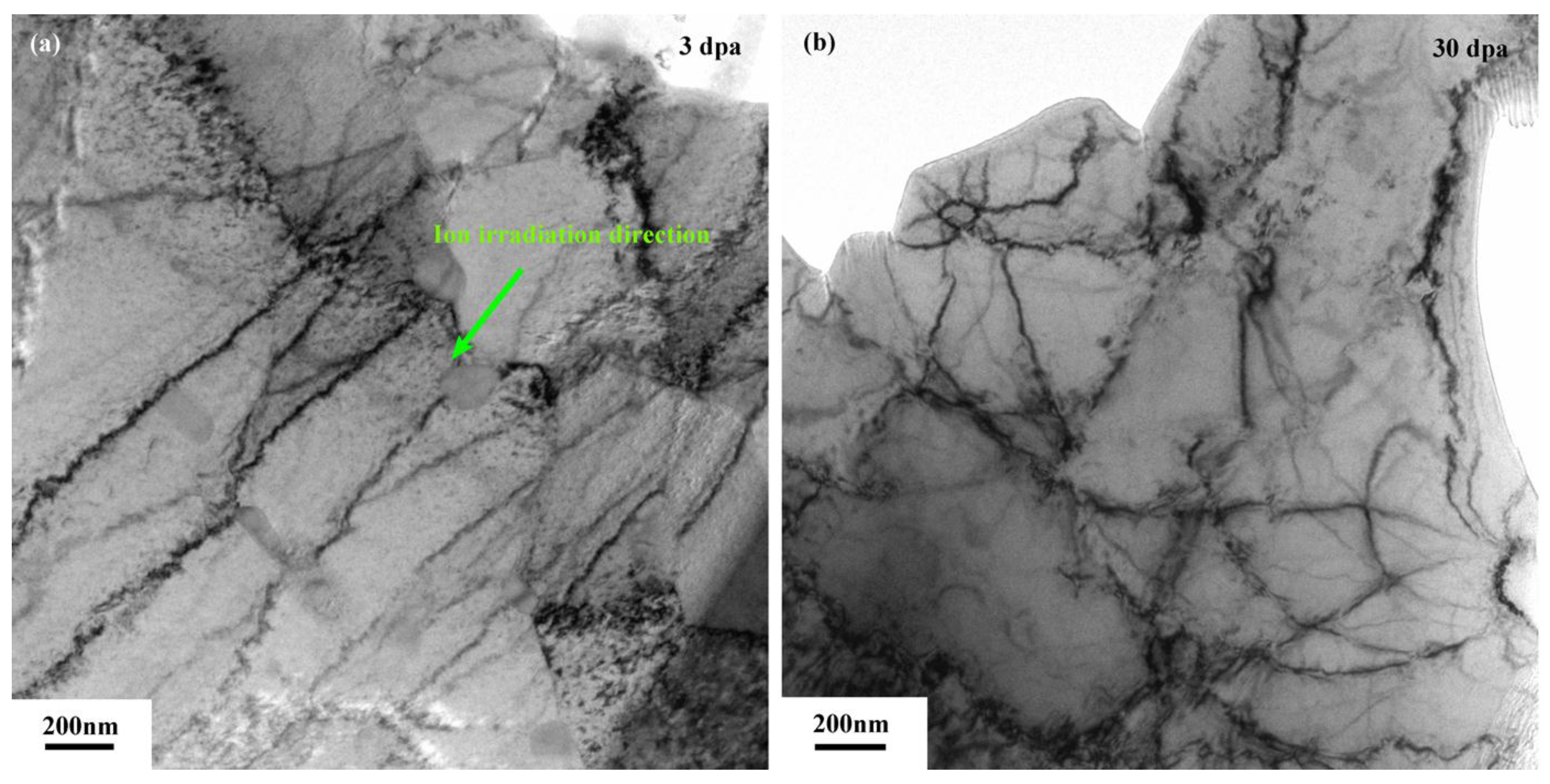
| C | Si | Mn | P | S | Ni | Cr | Cu | Mo | Al | Fe |
|---|---|---|---|---|---|---|---|---|---|---|
| 0.15 | 0.36 | 0.34 | 0.011 | 0.008 | 3.26 | 1.66 | 0.041 | 0.46 | 0.005 | Balance |
| dpa | Fluence | Duration (min) |
|---|---|---|
| 1 | 2.46 × 1015 | 14.01 |
| 2 | 4.92 × 1015 | 28.02 |
| 3 | 7.38 × 1015 | 42.03 |
| 10 | 2.46 × 1016 | 140.1 |
| 20 | 4.92 × 1016 | 280.2 |
| 30 | 7.38 × 1016 | 420.3 |
© 2017 by the authors; licensee MDPI, Basel, Switzerland. This article is an open access article distributed under the terms and conditions of the Creative Commons Attribution (CC-BY) license (http://creativecommons.org/licenses/by/4.0/).
Share and Cite
Bai, X.; Wu, S.; Liaw, P.K.; Shao, L.; Gigax, J. Effect of Heavy Ion Irradiation Dosage on the Hardness of SA508-IV Reactor Pressure Vessel Steel. Metals 2017, 7, 25. https://doi.org/10.3390/met7010025
Bai X, Wu S, Liaw PK, Shao L, Gigax J. Effect of Heavy Ion Irradiation Dosage on the Hardness of SA508-IV Reactor Pressure Vessel Steel. Metals. 2017; 7(1):25. https://doi.org/10.3390/met7010025
Chicago/Turabian StyleBai, Xue, Sujun Wu, Peter K. Liaw, Lin Shao, and Jonathan Gigax. 2017. "Effect of Heavy Ion Irradiation Dosage on the Hardness of SA508-IV Reactor Pressure Vessel Steel" Metals 7, no. 1: 25. https://doi.org/10.3390/met7010025






